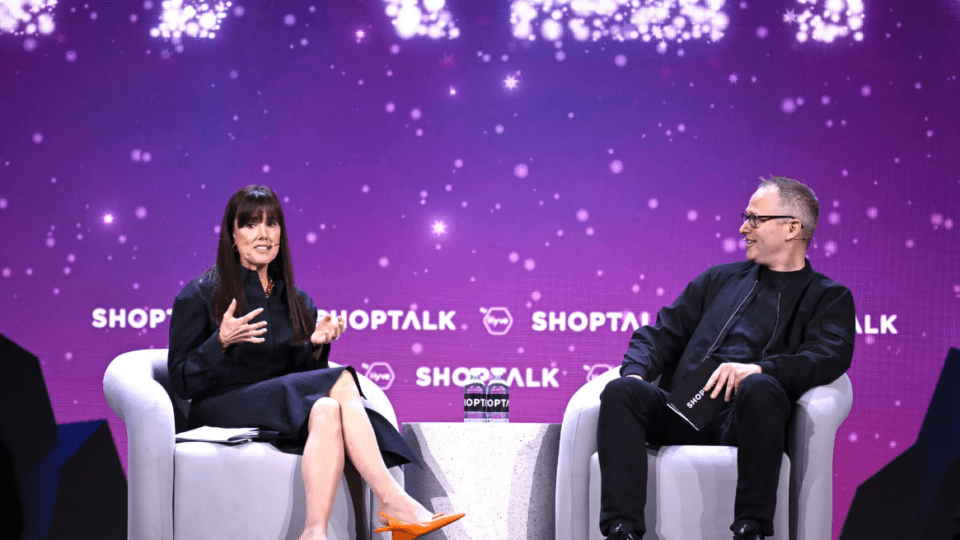Amara’s Law posits that humans tend to overestimate the impact of new technologies in the short term but underestimate their impact in the long term. Over the past few decades, we humans have been presented with countless opportunities to test this theory, from the introduction of the internet and smartphones to our more recent encounter with the metaverse (short-term impact definitely overestimated, long-term…remains to be seen).
The latest technology to capture the attention of the world is AI. And while it certainly seems to have more “legs” than the metaverse, after more than a year in the spotlight there does seem to be a recognition that the topic is caught up in a bit of a hype cycle.
Still, executives appear to be getting more clear-eyed about the role of AI in the retail industry: During an impromptu poll at Shoptalk in Las Vegas last week, the response was counter to what Amara would have predicted — two-thirds of executives in the room said they think the short-term impact of AI will be lower than expected, and the majority agreed that the long-term impact will be higher.
Regardless of the time frame, the expectations for AI are still sky high, which is one reason that the topic won’t likely be going away any time soon. It permeated the four-day Shoptalk event, just as it did the NRF Big Show in January (and likely many other upcoming gatherings). So to help you stay on top of the current sentiment around AI in retail, we’ve pulled together some of the core themes and commentary on AI from last week’s show.
Advertisement
Experts Agree: AI will have a Huge Impact on Retail
“We see AI as having the potential to really change shopping in three key ways: First is enabling more connection between brands and consumers; second, in building assistive experiences so that businesses can make better decisions; and lastly, in supercharging more personalized experiences for your consumers at scale,” said Maria Renz, Global Head of Commerce at Google in a keynote session.
Karin Tracy, Head of Industry for Retail, Fashion and Luxury at Meta pointed to very similar applications, saying “it’s incredibly impressive what we’re seeing in terms of predictive analytics, personalization and the promise of channel-less shopping.”
Indeed, enhanced personalization across all aspects of the online consumer experience was one of the most promising areas of existing and future AI use presented throughout the show. “I think we’re beginning to see the UX of the future,” added Google’s Renz. “It’s a whole next level of personalization. What we’re seeing is AI enable a different level of interaction with consumers where a consumer can really shape their purchase experience.”
Emma McFerran, CEO of the UK-based shopping platform Lyst, went so far as to say that “online shopping could look and feel entirely different in a decade.”
And retailers don’t want to be left behind. Meta’s Tracy said that research done by the company found that two-thirds of the retail industry plans to implement a consumer-facing AI solution within the next six to 12 months.
Retailers may not need to rush though. Vic Drabicky, Founder and CEO of digital consultancy January Digital, said that AI’s rise to prominence is helping executives “think really big and crazy” because the “promise of AI unleashes so much productivity,” but much of that promise is as yet unrealized.
“AI technology has been around for a while, but just [a little over a year ago] it became mainstream,” he said in a conversation with Retail TouchPoints. “It will take another year for there to be real, usable products, and probably another year before there’s very established players and workstreams that are individualized. It took OpenAI something like $20 billion and how many years to build theirs?
“People in this industry who have been doing this work for the last 10 years will tell you that so much of this was possible before,” Drabicky added. “The difference now is it’s such a conversation that somebody on the board is sending an email going, ‘What’s our AI plan?’ The money is starting to flow through, and I think this time next year will be unbelievably exciting. When the computer came along it changed the whole world in a short amount of time; AI has the same power, and the timeframe will be far more condensed.”
For that reason, Ting Cai, Chief Data Officer at Rakuten Group, said that “everybody needs to leverage this technology. If the overall playing field is elevated, but you don’t understand the latest technology and play with it, you will be left behind. Enable an experimentation framework so you can quickly evaluate different models and choose the best one for your scenario,” he advised.
Cai also noted that AI is allowing smaller companies to compete with the big players in a way that wasn’t possible before, and Dan DeMeyere, Chief Product and Technology Officer at resale site ThredUp, agreed: “The rate of technology change in this space is enabling retailers to inject so much more convenient experiences into the broader shopping experience,” he said in a Shoptalk session. “Anyone that runs any sort of ecommerce experience needs to be understanding what AI can do for you.”
Retailers are Already Seeing Results, Albeit in Smaller Use Cases
Despite the general excitement about the potential of AI to transform the retail experience, use cases so far tend to be in narrow, targeted applications.
“The one thing I’m excited about [so far] is the merchandising capabilities,” said Sarah Engel, President of January Digital in an interview with Retail TouchPoints. “That is one thing that I’ve seen come a long way in the last year and that a lot of retailers are already using. Conversion rates are so tough right now, so that [particular use case] makes me really excited.”
ThredUp’s DeMeyere gave a perfect example — the platform’s new AI-powered search, which has vastly improved the ability of customers to find the products they’re looking for amid ThredUp’s massive inventory of pre-owned goods.
“Four million unique SKUs is a blessing and curse,” he said. “If you search ‘dresses’ and get 50,000 results, that’s not helpful. If you can’t find what you’re looking for quickly, that’s inconvenient, and if you [as a platform operator] want to have a customer put up with the burden of that shopping experience, you have to lower your prices, [which no one wants to do]. So this is a challenge that we’ve been working on for a while. Up until very recently we haven’t had any big breakthroughs, but AI has changed that.
“What we’ve been doing is unlocking the language of style, the ability to search for things that aren’t in your catalog or your taxonomy — that is, things you haven’t tagged,” DeMeyere explained. “Now if you search for ‘academic chic’ or ‘first date outfit’ [on ThredUp] you’re going to get surprisingly relevant results, despite us not having any of that data in our search index. AI is just so much better than humans when it comes to looking at imagery, understanding the search terms and connecting the two. And this is something that wasn’t available a year ago.”
Carrie Sweeney, VP of Retail Partnerships at Pinterest, has similar ambitions for discovery on her platform, saying in a session that in the long term she wants every piece of content on Pinterest to be dynamically personalized to every user. While that capability is being developed, she’s currently focused on more specific but impactful applications, like generating lifestyle backgrounds for image photos. Sweeney pointed to the fact that on Pinterest, images with lifestyle backgrounds consistently have higher click-through rates than those with white backgrounds, and gen AI can help creators easily create those kinds of images at a scale and speed they couldn’t before.
For the Moment, Experimentation is the Goal
“Last year, there was a lot of hype; everyone was talking about AI, and we launched a lot of tech,” said Google’s Renz. “Now we’re seeing a lot of reaction from both businesses and consumers, and the teams are starting to focus. They’re pulling on the thread of the things that seem to be gaining traction. I’ve been in [retail] 25 years, and this feels a little bit like the early days of ecommerce — everyone’s excited, but then you get to the hard work. You’ve got to put in the time and the work, and then all of a sudden it becomes something really special. It feels like we’re in that cycle again; I can’t wait to see where it goes.”
For its part, ThredUp isn’t stopping with its new and improved search experience. The company’s CEO James Reinhart told Retail TouchPoints that it is now developing gen AI technology that can help curate outfits for shoppers, a particularly difficult challenge on a platform full of single-SKU products where “by the time you click on an item, it’s been sold,” he said. The new tool would help users quickly and easily move from a text-based description to a full outfit composed of available products.
For many companies, the key right now is to test out AI while keeping an eye on the big picture: “We’re currently experimenting with the technology and we certainly think there’s a lot of promise, but I tend to be of the view that 80% of our focus simply needs to be that if you order mascara you get your mascara,” said Fuad Hannon, VP of New Verticals at DoorDash in an interview with Retail TouchPoints. “AI can’t solve that. It can’t pick up the right shade of foundation or get you the bananas you want to make banana bread. Those are really hard physical world problems. So we’re certainly exploring and in early pilot phases with some AI technologies, and they’re starting to show a lot of promise, but the lion’s share of the work, at least for me, will be the physical world.”
Current Challenges — Staying Focused and Measuring ROI
The promise of AI could take many different forms, and that can actually be one of the biggest challenges as companies look to harness this tech: “It’s about focus; it’s easy to get excited,” said Max Magni, Chief Customer and Digital Officer at Macy’s Inc. in a session, adding that at the moment his team is focusing their AI experimentation on “core applications centered on the customer experience; anything that can positively impact omnichannel CX.”
“For us right now it’s about managing the expectations of what we can actually do with this technology and finding those use cases,” said Mokshika Sharma, VP of Technology at Sur la Table in a different session. “There are a lot of times where we develop or invest in technology and then at the end of the day, there’s no outcome. And with this type of technology, you can very easily spend a lot of money, because it does get very pricey.”
In fact, because of the cost of developing and testing new AI solutions, Rakuten’s Cai said that measuring and even defining the ROI of these investments is one of his biggest challenges: “To identify the true benefit of generative AI, we need to look at every single manual task we do, capture how many hours people spend [doing it], and [and calculate] how much time they save [with AI]. That’s one of the ways we’re measuring ROI.”
Another inevitable cost that Macy’s Magni said he sees coming down the pike is change management, which he anticipates will be “really dramatic.” And while that may mean some jobs will be lost, other new jobs will be created, as they have in previous moments of mass technological innovation.
“We think AI is going to be more transformative and bigger than anything that we could ever imagine today, but at the heart of it are people, the human element,” said Meta’s Tracy. “No matter how powerful these tools become, humans will be a critical part of this, because people can understand context and make effective strategies and interpret the data that’s most useful.”
“There’s real skill in the ability to get the best out of these tools,” said Lyst’s McFerran, who predicted that prompt engineer (a specialist in developing, refining and optimizing text prompts for AI content generators) will become a huge role in organizations in the near future.
Of course, dealing with any new and relatively untested technology always comes with risk, and many executives at Shoptalk were very open about their fears and approach to managing this risk, particularly in light of a range of high-profile snafus among some of the biggest players in the space.
For example, just as Shoptalk was kicking off, Google announced it is readying to relaunch its AI image generator Gemini after pausing access to the tool following a series of embarrassing incidents. These included the generation of inaccurate images depicting groups like America’s founding fathers and Nazi soldiers as Black. The outputs were apparently the result of an overcorrection toward inclusivity following the company’s previous gorilla scandal in 2015, when Google’s photo app was found to be tagging images of Black people as gorillas.
Clearly, AI has much to learn, as do the humans looking to harness this technology. “Gen AI puts risk on steroids,” said Macy’s Magni, who said he now brings the legal team in at the beginning of projects as part of a cross-functional group aimed at avoiding potential pitfalls from the outset. But that risk isn’t deterring Magni from aggressively pursuing AI solutions, and he said it shouldn’t deter anyone else either: “The risk is important to be aware of, but it’s not where we start,” said Magni. “Done right you can change the trajectory of the whole business, so the risk shouldn’t limit you.”









